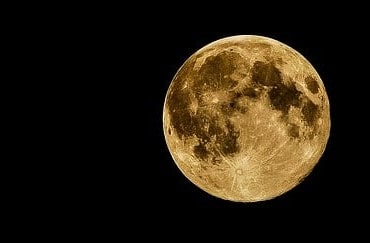The Moon was but a Chin of Gold by Emily Dickinson
In “The Moon was but a Chin of Gold,” Emily Dickinson metaphorically compares the moon to a woman’s face. The poem’s title is reflective of the crescent moon compared to a “Chin of Gold.”
Plenty of encomiums have been showered on Emily Dickinson, a popular elusive figure in American poetry, also known as “The New England Mystic” and “The White Myth of Amherst”. She was born on December 30, 1830, in Amherst, Massachusetts. She is an inspirational icon of transgression, firmly refusing to be confined by societal and literary norms. Unlike traditional poets, she used unusual capitalization, long dashes, and odd punctuation. Her eccentric style of writing set her apart from contemporary poets. From the age of 31, she dressed in white. She spent most of her time in seclusion and sought solace in nature.
Dickinson was reclusive and started dressing in a wholly white garment. That’s why she was recognized as “The White Myth of Amherst”. In fact, after her death, she was buried in a white dress, coffin, and casket lining. Why she wore a white dress is unknown, but there is no doubt about a strong connection between Dickinson and the white color. Critics speculate that her habit of dressing in white was a result of “her frustrated love for a married man, [and] that she dressed in white in order to be the priestess at the altar of love.”
Critics have meticulously discussed the importance of colors in Dickinson’s poetry. There have been many debates on the significance of “whiteness” in her poems. Several critics claim that “whiteness” connotes her staunch rejection of multiple forms of worldliness. Vivian Pollak comments that Dickinson invokes “white” color in her poems to portray the traditional links between whiteness and “feminine self-denial and self-sacrifice”.
One of the boldest interpretations of the “white” color in her poems was attempted by Sandra Gilbert and Susan Gubar. They deeply analyzed her habit of dressing in white and postulated that “whiteness” for Dickinson functioned as a symbol of purity, ethereality, self-sacrifice, and a tropological “self- enclosing armor” buttressing sovereignty and independence of women.

In “The Moon was but a Chin of Gold,” Emily Dickinson metaphorically compares the moon to a woman’s face. The poem’s title is reflective of the crescent moon compared to a “Chin of Gold.”

“If I can stop one Heart from breaking” (919) by Emily Dickinson is about the poet’s wish to help one individual in their need in order to give meaning to her own life.

“I cannot live with You –” (640) is a “Quaint” love lyric composed by one of the greatest 19th-century American poets, Emily Dickinson.

Emily Dickinson’s “To fight aloud, is very brave –” is about the individual struggles and hardships that people often have to deal with in life.

“I had no time to hate, because” by Emily Dickinson is about the speaker’s disillusionment of love and hate induced by life’s brevity.

In “The Brain, within its Groove,” Emily Dickinson describes how the Brain runs smoothly when following a particular course of thought.

Emily Dickinson’s poem “If you were coming in the Fall” is about the pining of a speaker who would have waited for a long time if she could be reunited with her lover.

Emily Dickinson’s “A Wounded Deer – leaps highest –” is about full-spirited desperation in times of dire need, for instance, while dying.

Dickinson’s “The Heart asks Pleasure—first—” is about the desires of an aching heart. It highlights what a person needs the most, down to the least.

Emily Dickinson’s poem “In a Library” is about “an antique book” from a library. The speaker compares the book to a wise old man with whom she spends some quality moments.